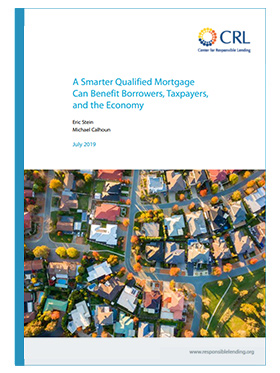In the Dodd-Frank Act, Congress required lenders to make a reasonable and good faith determination that the borrower has the ability to repay a mortgage loan (ATR) before the loan is made. It also created a category of loans, called Qualified Mortgages, or QM, that are presumed to comply with the ATR requirement given product and borrower credit characteristics that make the loans lower risk. The product protections for a loan to be considered a QM are outlined in the Act, and the credit characteristics are left to the Consumer Financial Protection Bureau (CFPB) to determine.
In setting the borrower credit characteristics, CFPB established a debt-to-income ratio (DTI) limit of 43% for QM loans and also provided three exceptions to permit lenders to obtain QM status while making loans above 43%. First, loans insured by the Federal Housing Administration, Rural Housing Services, and Veterans Administration would be covered instead by rules those agencies develop. Second, community banks that hold loans in portfolio would automatically receive QM status regardless of DTI, since these loans have historically performed well. Finally, since CFPB wanted to permit higher DTI loans with compensating factors but did not want to prescribe detailed underwriting criteria itself, it exempted loans eligible for purchase or guarantee by Fannie Mae or Freddie Mac (the government-sponsored enterprises, or GSEs) from the DTI limitation for seven years or until the GSEs cease to be in conservatorship.
In the absence of the GSE provision, called the GSE Patch, almost 19% of the loans guaranteed by the GSEs over the last five years—3.3 million loans—would not have been QM. Letting the Patch expire on schedule in January 2021 and subjecting these loans to a flat 43% DTI limit would thus have a dramatic impact on mortgage lending in the country.
